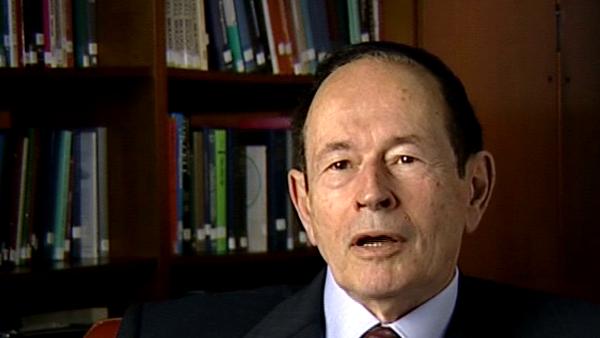NEXT STORY

'Making an organism is a pretty horrendously complex thing'
RELATED STORIES

NEXT STORY

'Making an organism is a pretty horrendously complex thing'
RELATED STORIES


|
Views | Duration | |
|---|---|---|---|
| 21. A visit from Leo Szilard | 640 | 01:01 | |
| 22. Completing work on the structure of gamma globulin molecule | 395 | 02:48 | |
| 23. Building a model of gamma globulin | 438 | 02:41 | |
| 24. Theorizing on the problem of how antibodies became different | 310 | 01:07 | |
| 25. Somatic recombination theory | 402 | 03:05 | |
| 26. Open and closed science | 449 | 01:50 | |
| 27. Into the field of embryogenesis and morphogenesis | 369 | 05:08 | |
| 28. Our laboratory as a chicken farm | 1 | 321 | 02:35 |
| 29. 'In my end is my beginning': Back to antibodies | 316 | 01:18 | |
| 30. The morphoregulator theory | 464 | 02:20 |


At this point I became intrigued with what I still think is an unsolved but central problem of embryology development, which is: how in fact do you inherit these changes, you know? And here I had what I might call an impoverished but I think definitely tenable theory of morphogenesis which I called the morphoregulator theory. It was this: that cell adhesion molecules governed where their cells stuck together or whether they... when the molecules went away, they moved and we did know all these things happened. And so if you could find out how the genes for cell adhesion molecules were controlled in sequence, in terms of a loop of behavior, that might regulate how it happens. Let me make it very clear, I hope, by giving you an example.
The cells of the spinal cord... remember I said you have gastrulation, then you form something call the notochord, and then you have nerve cells that present themselves to make a spine... at the top of the spinal cord are a set of cells called neural crest cells – neural crest because they're at the top. What they do is they disassociate from the cord and migrate in definite pathways to form the peripheral nervous system – in fact some of the bones of your face – and they're very well-known, and they're in fact the source of melanin pigment, etc., in one branch. So what we found out was they were held together at the top of the spinal cord by this neural cell adhesion molecule, but the minute they were to migrate, the molecule disappeared from the cell surface, the genes were turned off, they'd migrate, go to a certain place, turn on this gene, put themselves back together again. Now obviously that doesn't explain the whole of shape. And since then it's been a brilliant set of efforts on the part of a variety of scientists to show that there are other kind of molecules that attract the cells in particular pathways, etc., etc. But I think the whole notion that the problem is to link the genetics with the mechanochemistry still remains as the central issue. And one of my colleagues here, Fred Jones, and I worked a long time on this and we showed that some very important set of genes that were determined by people working on fruit flies.
US biologist Gerald Edelman (1929-2014) successfully constructed a precise model of an antibody, a protein used by the body to neutralise harmful bacteria or viruses and it was this work that won him the Nobel Prize in Physiology or Medicine in 1972 jointly with Rodney R Porter. He then turned his attention to neuroscience, focusing on neural Darwinism, an influential theory of brain function.
Title: The morphoregulator theory
Listeners: Ralph J. Greenspan
Dr. Greenspan has worked on the genetic and neurobiological basis of behavior in fruit flies (Drosophila melanogaster) almost since the inception of the field, studying with one of its founders, Jeffery Hall, at Brandeis University in Massachusetts, where he received his Ph.D. in biology in 1979. He subsequently taught and conducted research at Princeton University and New York University where he ran the W.M. Keck Laboratory of Molecular Neurobiology, relocating to San Diego in 1997 to become a Senior Fellow in Experimental Neurobiology at The Neurosciences Institute. Dr. Greenspan’s research accomplishments include studies of physiological and behavioral consequences of mutations in a neurotransmitter system affecting one of the brain's principal chemical signals, studies making highly localized genetic alterations in the nervous system to alter behavior, molecular identification of genes causing naturally occurring variation in behavior, and the demonstration that the fly has sleep-like and attention-like behavior similar to that of mammals. Dr. Greenspan has been awarded fellowships from the Helen Hay Whitney Foundation, the Searle Scholars Program, the McKnight Foundation, the Sloan Foundation and the Klingenstein Foundation. In addition to authoring research papers in journals such as "Science", "Nature", "Cell", "Neuron", and "Current Biology", he is also author of an article on the subject of genes and behavior for "Scientific American" and several books, including "Genetic Neurobiology" with Jeffrey Hall and William Harris, "Flexibility and Constraint in Behavioral Systems" with C.P. Kyriacou, and "Fly Pushing: The Theory and Practice of Drosophila Genetics", which has become a standard work in all fruit fly laboratories.
Tags: Fred Jones
Duration: 2 minutes, 20 seconds
Date story recorded: July 2005
Date story went live: 24 January 2008